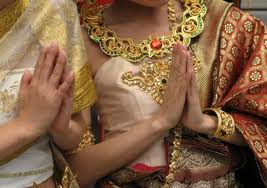
 |
|
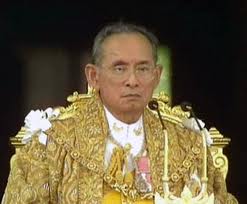 The Royal Family The Royal Family is highly revered. No lack of respect or criticism is accepted. The law of lese majesty is alive and well. In many country areas the Royal Anthem is played at eight o'clock in the morning, and at six in the evening when everything grinds to a halt. Be mindful even of offending images of HM the King such as stepping on bank notes, coins, etc. 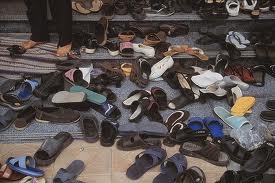 Taking off Shoes For hygiene purposes, houses in Thailand are shoe-free. It is considered most rude to drag dirty shoes into Thai houses. This certainly extends to all temple buildings as well as some businesses and restaurants. A safe way to make sure that you are doing the right thing would be to look around at any building entrance for signs of shoes and take yours off if you see that everyone else has. >>>>>>>>>>>>>>>>>>>>>>>>>>>>>>>>>>>>>>>>>>> >>>>>>>>>>>>>>>>>>>>>>>>>>>>>>>>>>>>>>>>>> Releasing Birds and Fish Much merit is obtained by freeing captive animals. This can be done on any special day such as a birthday or anniversary but is most often seen during the Songkran Festival (The Thai New Year celebrated in April). Little birds can be bought to set free at many temples and shrines. Fish are released in temple ponds, where they will breed in safety or in the rivers and lakes. Sometimes even turtles, shell fish and eels are bought from markets and set free to save them from the wok. *************************************************************** A BRIEF HISTORY LESSON 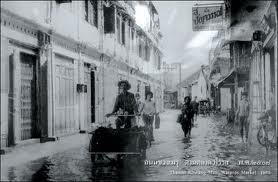 There has been continuous habitation in what is now Thailand for over 10,000 years. Thailand lies between the two great civilizations of India and China and it has been much influenced by the both. Coastal trade came up the river to Siam, as the old capital now known as Ayutthaya, was called. Elephants or ox carts also carried goods across the narrow isthmus to avoid the long and pirate infested route through the Malacca Straight. Over the centuries great Empires rose and fell in South East Asia - most of them being maritime states feeding off the merchants who traded along the coast. Such was Srivijaya based, some say, in Sumatra, the Khmer Empire of Angkor and the powerful kingdoms of Burma. Far to the north lay China, which sometimes stretched its tentacles down to the south. Lanna, as the kingdom whose capital was called Chiang Mai, sits right in the middle of all these powers - a land-locked country surrounded and divided by forests and great mountain ranges straggling down from the Himalayas. By 1300 A.D. the Thai people, moving out from the peripheral areas of China, had established themselves in the northern parts of Thailand. The two most important Thai kingdoms were Lanna and Sukothai, which was, a hundred years later, absorbed into Siam based at Ayutthaya. By the middle of the fifteenth century Lanna was firmly established, it fought successful wars against Siam over disputed territory and it became a major centre of Buddhist studies, hosting the Seventh World Buddhist Conference in 1477. Chiang Mai was also the key market on the trade routes from Yunnan to the Burmese ports where goods arrived from, and were sent to, India and beyond. |
|
Etiquette Thai people are remarkably friendly, but learning a little about the culture will hold you in even greater esteem. Note the foot taboos, feet are considered both vulgar and low, so don't point your feet at anyone or anything. Another important point to remember is not to touch people on the head, try not to even pat young children on the head as President Johnson should have been warned. Thais will be pleased if you wait them on meeting, (join your fingers together and with palms touching, bend your head slightly and touch your nose with the tips of your fingers), but you may well find that the reply is an outstretched hand waiting to be shaken. When offered something such as a glass of water, try and receive it with both hands. Try not to pass between two people who are talking, if you have to, make the gesture of ducking slightly. None of these mistakes would cause you any trouble, but do it right and you will earn respect. ///////////////////////////////////////////////////// Thai Culture Don't be embarrassed when you see Thai people kneeling or even crawling before their elders and betters - it is for them perfectly acceptable and in no way humiliating. You do not need to follow suit. Thai humor is splendid and often very bawdy, however it is sometimes difficult to translate foreign humor, so don't be offended if no one laughs at your jokes. The class system flourishes here in Thailand. Things you can do and say with one person may not go down at all well with another. If you learn a little Thai from a friend who may use lots of slang, another friend will know exactly where you have been - so be careful! Accent has little place in Thai so by changing the words you use you can easily alter your social position. It is better not to ask negative questions as Thais do not know whether to say yes or no in reply. Yes in Thai can mean many things. "Yes, I heard you but I haven't a clue what you mean". "Yes, I heard you, I understand what you want but I don't agree with you and I won't do it". Yes, I heard you, I agree with you and I will try and do it". Try to keep calm and relaxed whatever the provocation or however frustrated you may be. Be polite, smile, try and make a joke, don't rush things and try to speak softly. Thais are adept at working things out in their own way and they do not like confrontation 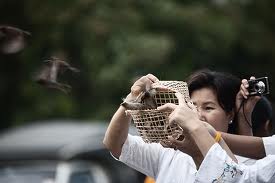 *************************************************** 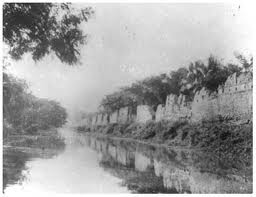 In 1557 the Burmese attacked the Thai world, utterly destroying Siam and turning Chiang Mai into a vassal state. For the next two hundred years Chiang Mai was an impoverished backwater cut off from the rest of the world and neglected by its rulers - it disappeared from the pages of history. In 1767 Burma struck at Siam again and reduced the great city of Ayutthaya to a pile of rubble and it never recovered, the capital was recreated at Bangkok. Slowly the kingdom of Siam recovered under the new Chakri Dynasty. A city and a region steeped in tradition and history, Chiang Mai has weathered seven hundred years of fascinating history. Chiang Mai, after being deserted for twenty years following the Burmese onslaught, was gradually repopulated and willingly gave its allegiance to the king of Siam. But the journey up the river to Chiang Mai was slow and difficult so that the Prince of Chiang Mai was virtually an independent ruler. The first American Presbyterian missionary to reach the north from Bangkok in 1867 records that the journey took him exactly three months. McGilvary's mission brought in the modern age - as well as, largely unsuccessfully, spreading the gospel, he also introduced modern medicine and education. Towards the end of the century British teak companies in Burma began to seek concessions in the north of Thailand. There were frequent conflicts with the Prince who saw nothing wrong with leasing the same concession to two different people.  The inhabitants of Chiang Mai are, as one would expect in a city situated at the crossroads of mainland South East Asia, a very mixed lot. The people living in the valleys think of themselves as Thais with a difference - they have their own distinct language and are in fact a mixture of Mon, Lawa, Lao and Thai Lue amongst others. To the west live many Shan and Karen while in the mountains, over the past hundred years, tens of thousands of hill tribe people have settled after fleeing from troubles in Burma, Laos and China - Hmong, Akha, Lisu, Musser, Yao and the long necked Padaung. There are also many overseas Chinese, Chin Haw Muslim traders from Yunnan and increasing numbers of Europeans and Americans who have come to live in the beautiful and gentle valley of Chiang Mai. |